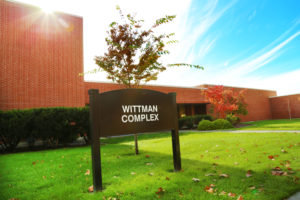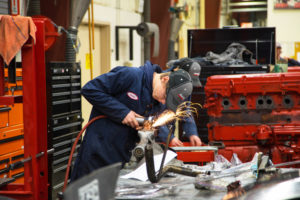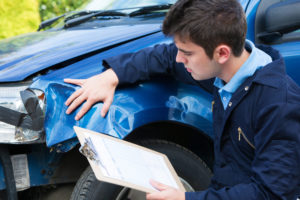The state of Idaho has awarded a $1.3 million grant to Lewis-Clark State College for building improvements and equipment purchases that will help it expand its collision repair technology program in response to unmet student demand and industry needs.
The Workforce Development Industry Sector Grant, issued by the Idaho Workforce Development Council, will also benefit the college’s diesel technology and welding technology programs. Announced Tuesday, it is the largest grant the college has received from the council to date.
“We are incredibly appreciative of this support and know the state-of-the art upgrades to facilities and equipment these funds will make possible will allow us to serve not only more students, but serve them and our industry partners better,” LC State President Cynthia Pemberton said in a statement.
 Currently, there’s room for 10 students in the collision repair program, and there’s a waiting list. The planned renovations to the Wittman Complex and Mechanical Technical Building on the Lewiston, Idaho campus will allow the college to expand the program, meet safety requirements, and create a better space for learning, with more work bays, training stations and Americans with Disabilities Act-compliant lab space.
Currently, there’s room for 10 students in the collision repair program, and there’s a waiting list. The planned renovations to the Wittman Complex and Mechanical Technical Building on the Lewiston, Idaho campus will allow the college to expand the program, meet safety requirements, and create a better space for learning, with more work bays, training stations and Americans with Disabilities Act-compliant lab space.
The college offers two-year associate degrees and two- and one-year certificates in collision repair technology. Students learn through a combination of classroom instruction and hands-on shop experience — the kind of combination of theory and practice that industry officials believe is needed to keep newly-minted technicians in the industry.
“Yes, there is work-based learning in the program, both in cooperation with employers and with the live repair work that the program does for the community,” Jeffrey Ober, Dean of Career and Technical Education at LC State, told Repairer Driven News. “We are working to find ways to expand this more and create more cooperation with employers in the area.”
LC State cited Department of Labor statistics that show there are 84 collision repair technician jobs to be filled each year in the region. The college says it has a 100 percent employment placement rate for its collision repair technology graduates.
“According to the Idaho Department of Labor, this field has a projected growth rate of 9.7% in the state of Idaho, with an estimated number of openings in the state at 122,” Ober said. “A quick web search shows 91 collision repair job openings today in Idaho (at indeed.com).”
Ober explained that collision repair technology is one of 10 programs in the college’s Career and Technical Education (CTE) division. Recently, seven of those programs were moved to a new building, the Schweitzer Career and Technical Education center.
“Part of that process made it so that the capacity of all those programs has been increased,” Ober said. “We are working on advancing the three programs in that division that did not move: diesel technology, welding technology and collision technology. We wanted to expand the capabilities of those programs and increase the capacity of each program.”
 Specifically, he said, the collision technology program is looking to add a Nova Verta Mixing Room, updated welding equipment, and a frame rack while expanding the outdoor learning lab space. “This should allow the program to increase enrollment and also allow students to experience additional skills and space with their collision lab. We can also serve additional members of the community with a larger space to allow students to work on live work,” he said.
Specifically, he said, the collision technology program is looking to add a Nova Verta Mixing Room, updated welding equipment, and a frame rack while expanding the outdoor learning lab space. “This should allow the program to increase enrollment and also allow students to experience additional skills and space with their collision lab. We can also serve additional members of the community with a larger space to allow students to work on live work,” he said.
Recently, there have been several efforts in higher education to draw people into the repair technician field and address workplace capacity issues. Currently, four colleges are offering training programs that combine school- and work-based learning through a two-year pilot program funded by The Enterprise Holdings Foundation.
Launched earlier this year and based on a hybrid school-and-shop educational model developed at Ranken Technical College in St. Louis, Mo., the “Automotive Collision Engineering Pilot Program” allows students to spend eight weeks at the school and then eight weeks working in a participating body shop, continuing this rotation over a 2-year period.
In addition to Ranken Technical Colllege, the pilot program is in place at three other schools: Contra Costa College in San Pablo, Calif.; Texas State Technical College in Waco, Texas; and College of Lake County in Grayslake, Ill.
Images:
Featured image: A student in Lewis-Clark State College’s collision repair technology program examines a fender. (Lewis-Clark State College)
The Wittman Complex and Mechanical Technical Building on the campus of Lewis-Clark State College in Lewiston, Idaho, is shown. (Lewish-Clark State College)
Two students in Lewis-Clark State College’s collision repair technology program are at work. (Lewis-Clark State College)
More information:
Information on Idaho Workforce Development Training Fund grants:
https://wdc.idaho.gov/workforce-development-training-fund.
Information on Lewis-Clark State College’s collision repair technology, diesel technology, or welding technology programs:
www.lcsc.edu/ti
Information on Lewis-Clark State College’s Workforce Training program:
www.lcsc.edu/workforce-training.
School and work-based learning pilot program reporting progress
Collision repair training pilot program benefitting from marketing fund
Share This:
Related



